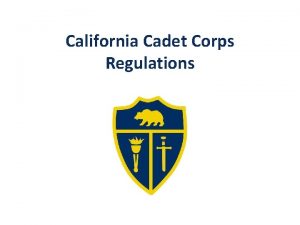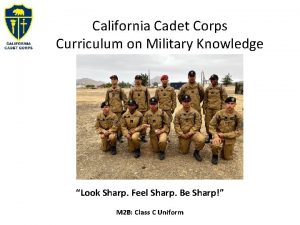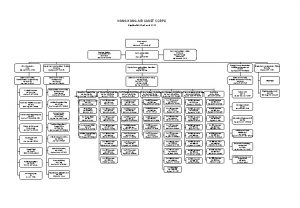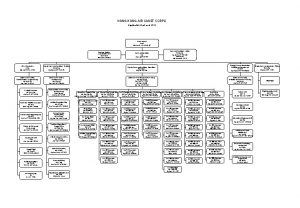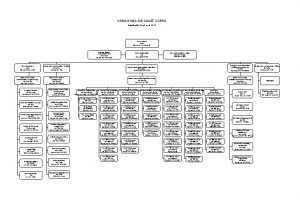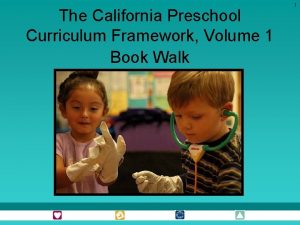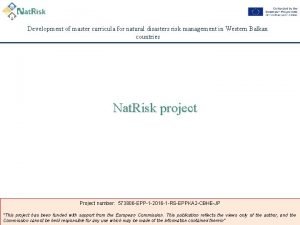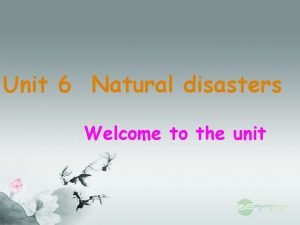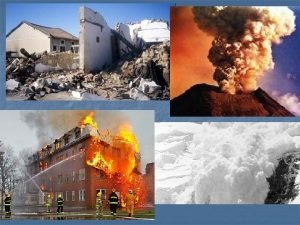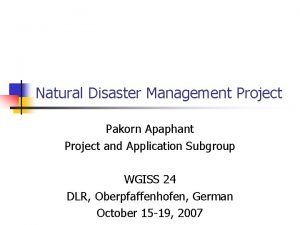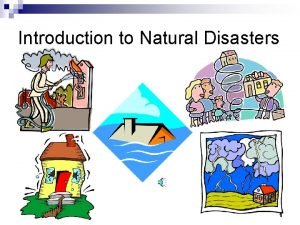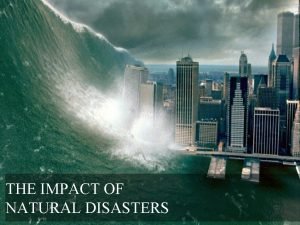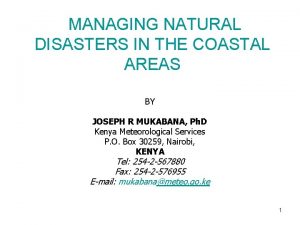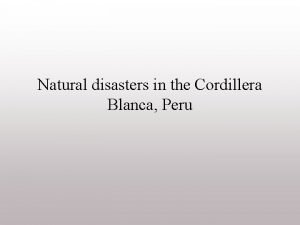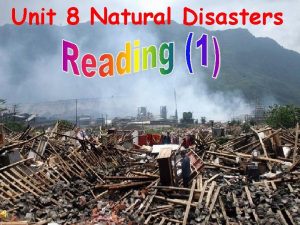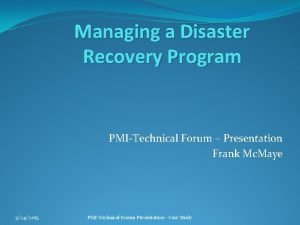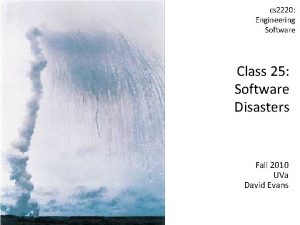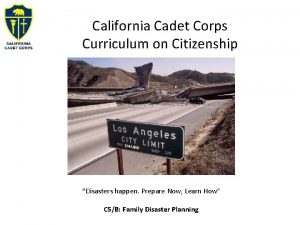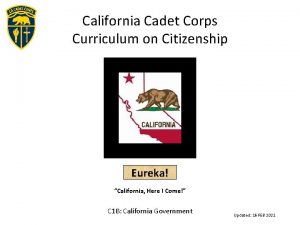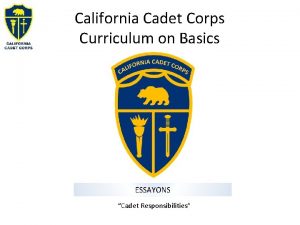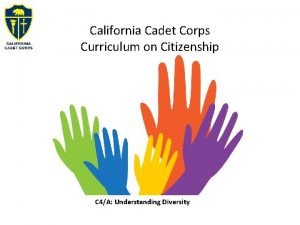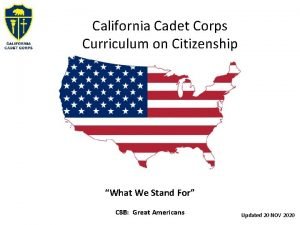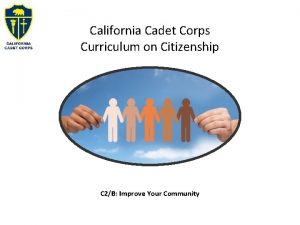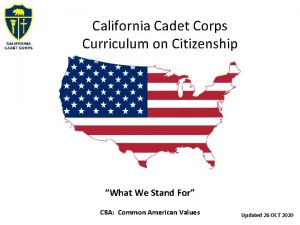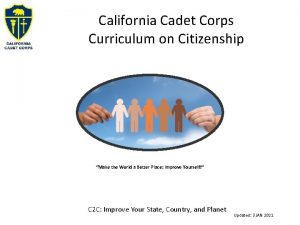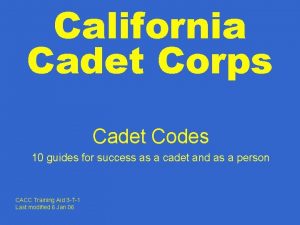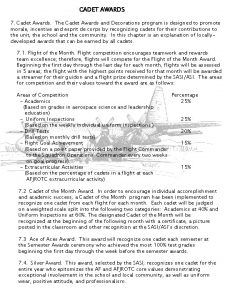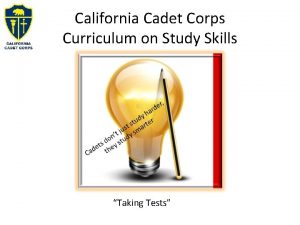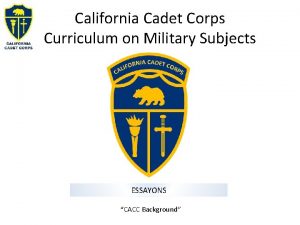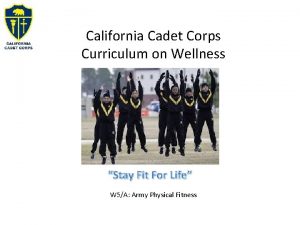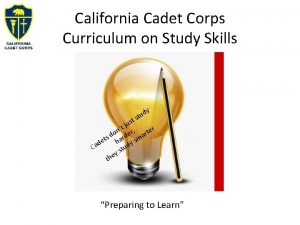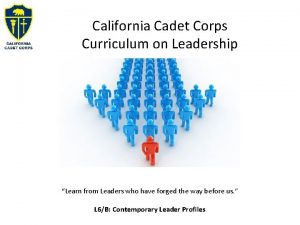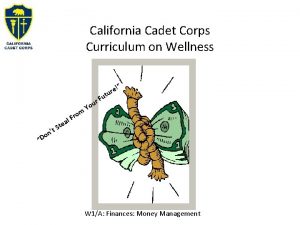California Cadet Corps Curriculum on Citizenship Disasters happen






































- Slides: 38

California Cadet Corps Curriculum on Citizenship “Disasters happen. Prepare Now, Learn How” C 5/B: Family Disaster Planning

CALIFORNIA DISASTERS AGENDA B 1. Make a Plan B 2. Shelter Plan B 3. Evacuation Plan and Route B 4. Communications Plan

CALIFORNIA DISASTERS: UNIT OBJECTIVES The desired outcome of this unit is for cadets to conduct family disaster planning. Plan of Action: 1. Assess the disaster related threats in your local area and put together a Family Disaster Plan. 2. Develop an adequate shelter plan for your family. 3. Develop an evacuation plan and routes. 4. Develop a disaster communications plan for your family.

MAKE A PLAN OBJECTIVES DESIRED OUTCOME (Self-Mastery) Cadets are familiar with the disaster emergencies that commonly occur in California and how to prepare, respond, and recover from them. Plan of Action: B 1. Assess the disaster related threats in your local area and put together a Family Disaster Plan. Essential Question: What is covered in an Emergency Plan and how do you go about putting one together?

Make a Plan

Assess Your Situation Step 1: Discuss the questions below with your family, friends, or household to start your emergency plan. 1. How will I receive emergency alerts and warnings? Check out the link, or curriculum lesson C 5 A 1. 2. What is my shelter plan? See Lesson B 2 3. What is my evacuation route? See Lesson B 3 4. Do I need to update my emergency preparedness kit? 5. Check with the Centers for Disease Control (CDC) and update my emergency plans 6. What is my family/household communication plan? See Lesson B 4

Your Specific Needs Step 2: Consider specific needs in your household. • • • Different ages of members within your household Responsibilities for assisting others Locations frequented Dietary needs Medical needs including prescriptions and equipment Disabilities or access and functional needs including devices and equipment Languages spoken Cultural and religious considerations Pets or service animals Households with school-aged children

Consider FEMA Information Active Shooter Attacks in Public Places Avalanche Bioterrorism Chemical Emergencies Cybersecurity Drought Earthquakes Explosions Extreme Heat Floods HAZMAT Incidents Home Fires Household Chemical Emergencies Hurricanes Landslides Nuclear Explosion Nuclear Power Plants Pandemic Power Outages Radiological Dispersion Device Severe Weather Snowstorms & Extreme Cold Space Weather Thunderstorms & Lightning Tornadoes Tsunamis Volcanoes Wildfires Many of these disasters are discussed in Section A of this Strand, but full information is available at https: //www. ready. gov/be-informed

Disaster Planning Checklist Fill one out for each disaster you want to be prepared for

Basic Emergency Plan Page 1 of 3

Basic Emergency Plan Page 2 of 3

Basic Emergency Plan Page 3 of 3

Plan for Pets Pet Emergency Supplies: • Food • Water • Medicines/Records • First Aid Kit • Collar w/ID • Leash Documents Crate/Carrier Sanitation Items Photo of you and pet • Toys, treats, bedding • • Consider 2 Kits: One full kit, one smaller version if you have to evacuate

Plan for Pets Make a Plan • Evacuate – how you will gather pets and where you’ll go • Develop a buddy system – neighbors, friends, or relatives • Talk to your Vet about planning • Gather contact information – animal control agencies, including Humane Society, ASPCA, and emergency vet hospitals

Practice! • • Step 3: Fill out a Family Emergency Communications Plan (Lesson B 4) Step 4: Practice your plan with your family/household – Practice texting and calling – Discuss what information you should text – Who will be the lead person to send out info about the meeting place – Practice gathering at meeting places – Regularly discuss the plan (at least annually) – Challenge memorization of phone numbers – Make sure everyone understands when to call 911

CHECK ON LEARNING 1. Your plan needs to take into account your specific needs. Examples of these are (select all that apply): a. Age of household members b. Favorite foods c. Disabilities and medical equipment used d. Political opinions about the government’s ability to manage an emergency 2. FEMA has published guidance on many types of disasters. Which of the following isn’t among them? a. Space Weather b. Nuclear Explosion c. Floods d. Zombie Apocolypse 3. T / F The Disaster Planning Checklist helps you fit general disaster information to your specific situation. 4. Your Disaster Plan should include (select all that apply): a. Communications Plan b. Meeting places or ways to contact each other c. A list of your Panic Room supplies d. Information on how you’ll save your pets

SHELTER PLAN OBJECTIVES DESIRED OUTCOME (Self-Mastery) Cadets are familiar with the disaster emergencies that commonly occur in California and how to prepare, respond, and recover from them. Plan of Action: B 2. Develop an adequate shelter plan for your family. Essential Question: What are the types of shelters and when do you use them?

You Need Water • Never ration drinking water • Drink water you know in not contaminated first • Don’t drink carbonated/caffeinated beverages instead of drinking water • Treat water by boiling, chlorinating, or distilling

You Need Food Store 3 days of emergency food supplies Canned, dry goods, non-perishables Keep food in covered containers Throw away refrigerated food that has been at room temperature for two hours or more or has an unusual odor, color, or texture • Don’t eat food from cans that are swollen, dented, or corroded, or smells abnormal • Keep garbage outside • Use dry ice to keep food cold • •

Shelters • Stay-At-Home – remain indoors as much as possible. Patios, porches, & yards are okay • Mass Care Shelter – provides life sustaining services to disaster survivors – Text SHELTER and a ZIP Code to 43362 for list • Sheltering in Place – at home, work, other – Assess situation for signs you can leave

Shelter in Place – Sealing a Room • Local authorities may not be up and running • TV/radio/internet • Family & Pets inside • Secure doors, windows, vents, fireplace dampers • Interior room if possible • Duct tape plastic sheeting over cracks around doors, windows, vents, etc.

CHECK ON LEARNING 1. Types of shelter in your Shelter Plan include all EXCEPT: a. Stay-At-Home b. Shelter-With-Family c. Mass Care Shelter d. Shelter In Place 2. Which of the following guidelines are given for Sheltering in Place (select all that apply)? a. Lock the doors, close the windows, air vents, and fireplace dampers b. Seal windows, doors, and air vents with thick plastic sheeting and duct c. d. tape Leave pets outside Watch TV and listen to the radio or check the internet for updates and official news 3. Which of the following conform to guidance on food safety? a. Keep food in covered containers b. Quickly eat any food that looks or smells abnormal, before it completely goes bad c. Don’t let garbage accumulate inside d. Throw away any food that has come into contact with contaminated flood water

EVACUATION PLAN AND ROUTE OBJECTIVES DESIRED OUTCOME (Self-Mastery) Cadets are familiar with the disaster emergencies that commonly occur in California and how to prepare, respond, and recover from them. Plan of Action: B 3. Develop an evacuation plan and routes. Essential Question: What do you need to take into account if you have to evacuate?

Evacuate! Many kinds of emergencies can cause you to have to evacuate. In some cases, you may have a day or two to prepare while other situations might call for an immediate evacuation. Planning is vital to making sure that you can evacuate quickly and safely no matter what the circumstances.

Evacuating • • Different disasters – different routes What do emergency planners tell you? If told to go – GO! Bring pets – but shelters may not allow them Communications & meeting plan If evacuation seems likely, keep a full gas tank Have an emergency kit in the car Plan for the weather

Before You Leave • Notify your out-of-area contact in your family communications plan • Lock doors and windows • Unplug electrical equipment • Leave a note saying where you went & when • Wear sturdy shoes, protective clothing (long shirt & pants) and a hat • Check on neighbors before you go

Coming Home • Don’t come until officials say you can • Notify friends and family • Keep a full gas tank • Bring food and water • Avoid downed power lines • Only use generators outside the home

CHECK ON LEARNING 1. If you’re evacuating because of an emergency, which of the following is NOT true? a. b. c. d. Identify several places you could go ahead of time Assume public shelters will allow you to bring your pets Develop a family plan to stay in touch in case you become separated Keep a full tank of gas if an evacuation seems likely 2. T / F FEMA keeps a list of shelters you can access if evacuating. Other governmental agencies provide this information as well. 3. Which of the following is true for an evacuation (select all that apply)? a. Leave your doors unlocked so emergency personnel don’t have to break in to secure your house b. Unplug electrical equipment. Leave freezers and refrigerators plugged in except in a flood. c. If there is damage to your home, you may need to shut off gas, water, and electricity before leaving. d. Wear sturdy shoes and clothing that provides some protection – long pants & shirt, a hat 4. T / F When returning after an evacuation, it’s a good idea to bring the items you’ll need to survive: water, food, gas, etc.

COMMUNICATIONS PLAN OBJECTIVES DESIRED OUTCOME (Self-Mastery) Cadets are familiar with the disaster emergencies that commonly occur in California and how to prepare, respond, and recover from them. Plan of Action: B 4. Develop a disaster communications plan for your family. Essential Question: How can you ensure your family will be able to find each other if a disaster happens?

Communications Plan Should contain: • Household information – phone numbers and email addresses for all household members. Don’t rely on Contacts in your phone! • School, Childcare, Caregiver, Workplace – What everyone does if you’re not home when it happens • Out of Town Contact – Someone out of the area everyone can contact as a central point so you can reconnect

Emergency Meeting Places • Safe, familiar places your family can go for protection or to reunite. Pet-friendly • Indoor for large weather-related emergencies • In your neighborhood for localized problems • Outside your neighborhood if you can’t get home • Out of town • Everyone should have the address, contact info, and a plan on how they can get there

op


Make wallet cards everyone can carry with key information on them.

Other Important Information • Phone numbers for emergency services, utilities, service providers, medical providers, veterinarians, insurance companies. • Make sure everyone has the info (in the cloud? ) • Enter household and emergency contact info in each family member’s phone • Store at least one emergency contact under the name “In Case of Emergency” or “ICE” • Know how to text, or alternative ways to communicate if they can’t text

Communication Tips • Text is best • Conserve phone battery – Reduce screen brightness – Airplane mode – Close apps you don’t need – No videos or games • Keep charged batteries, a phone charger, and a solar charger in your emergency kit • Don’t text while driving!

Communication Tips • Maintain a household landline • Call-forward your home phone number to your mobile phone number • Use the Internet to communicate • If no mobile phone, carry a prepaid phone card • Pay phones (if you can find one) don’t rely on electricity or mobile networks

CHECK ON LEARNING 1. Which of the following should be in your communications plan? a. b. c. d. Contact info for all family and important outside contacts Planned meeting places if you get separated Contact information for the local mayor’s office Medical and insurance information 2. When communicating during a disaster, which is better to use, text or phone? _________ 3. In a communications plan, “ICE” stands for: I____________ C____________ E____________ 4. T / F Though losing its popularity and convenience in daily life, having a landline telephone during emergencies is an asset.
 California cadet corps website
California cadet corps website Cacc ribbons
Cacc ribbons California cadet corps class b uniform
California cadet corps class b uniform California cadet corps class c uniform
California cadet corps class c uniform Cadet corps uniform
Cadet corps uniform Hong kong air cadet corps
Hong kong air cadet corps Six cadet corps objectives
Six cadet corps objectives Cadet corps core values
Cadet corps core values Hong kong air cadet corps
Hong kong air cadet corps Hk air cadet corps
Hk air cadet corps The order in which things happen
The order in which things happen Pre k curriculum california
Pre k curriculum california Natural hazards vs natural disasters
Natural hazards vs natural disasters Natural disasters listening comprehension
Natural disasters listening comprehension Natural disasters
Natural disasters Three natural disasters
Three natural disasters Man made disasters conclusion
Man made disasters conclusion Accidents & disasters
Accidents & disasters What are disasters
What are disasters Disaster definitions
Disaster definitions English language paper 2 rail disasters mark scheme
English language paper 2 rail disasters mark scheme Natural disasters impact on environment
Natural disasters impact on environment Natural disasters
Natural disasters Conclusion of natural disasters
Conclusion of natural disasters Most historians agree that military disasters
Most historians agree that military disasters Disaster management
Disaster management Helike greece
Helike greece Emergency care first aid and disasters
Emergency care first aid and disasters Unit 9 natural disasters
Unit 9 natural disasters Natural disasters conclusion for project
Natural disasters conclusion for project Introduction natural disasters
Introduction natural disasters Natural disasters in the cordillera region
Natural disasters in the cordillera region Taiwan earthquake
Taiwan earthquake Man-made disasters introduction
Man-made disasters introduction Types of disasters
Types of disasters Software engineering disasters
Software engineering disasters Ancient natural disasters
Ancient natural disasters Crash that is speeding
Crash that is speeding Positive effects of earthquakes
Positive effects of earthquakes
